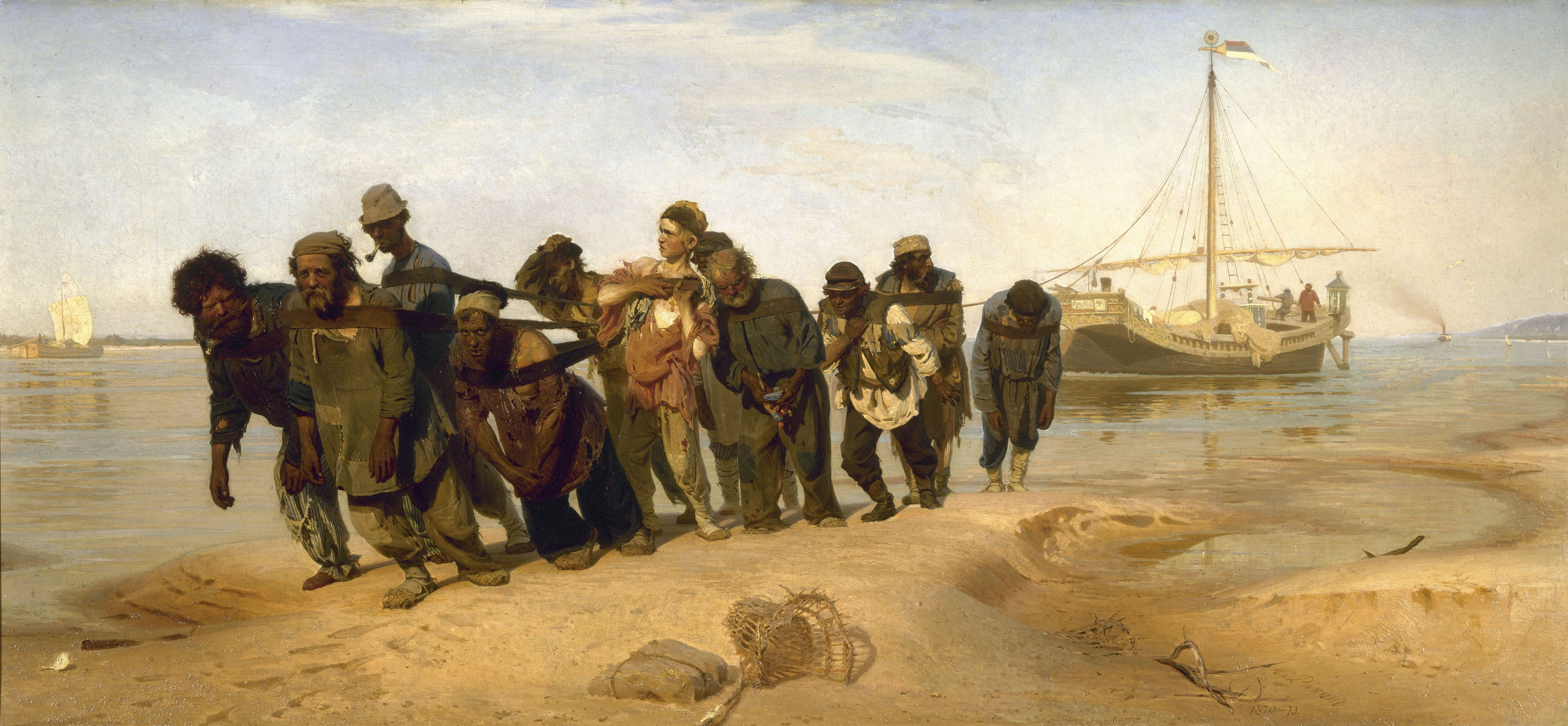| Painting Name | Barge Haulers on the Volga |
| Painter Name | Ilya Repin |
| Completion Date | 1873 |
| Size | 281 x 131.5 cm (9' 2.63" x 4' 3.77") |
| Technique | Oil |
| Material | Canvas |
| Current Location | State Russian Museum (St. Petersburg Russian Federation) |
A funny experience the artist, Ilya Repin, had was that people were afraid of giving a pose for the painting as there was a belief among illiterate haulers that once a person’s image is put down on a paper, his soul leaves his possession. Finding no model (even after offering a fee) for his painting, he created all of his unique characters during his journey through Russia.
The painting represents the hardship of the poor people in old times, around late 19th century. Painter gave importance to the hard life of the haulers by making this grand picture, which he asserted as his first professional painting. That time, the industrial revolution had just begun and a steam boat in far background on the left side shows some smoke. It could make us think that this hard laboring is no more necessary in the rising time of machinery and industries. This little staffage ads a great degree of depth at understanding in what kind of times the haulers were living through. It is almost like making someone do a persecuting job just because keeping him is cheaper and easier.
Though, in real life, those haulers were the isolated people and almost unseen by the regular, normal community who had no time from playing musical nights with their aristocrat friends. Though, social imbalance exists in every time period. Though, social imbalance exists in every time period. So, no complaints there.
Even after the negligence by the upper society, these haulers represent a man’s core made of dignity and self-sustaining living. This group also reflects a unity which has automatically developed by working together for a long time. Extreme hardships of life can sometimes make people enemies but most of the times, it makes people stand together to fight the adversity. These people may not have the aristocratic manners with hoity-toity looks and expressions, but they would surely have tighter bonds with each other which can reach beyond the normal meanings of friendships. ‘Family’ would a more appropriate word for such group.
The painter himself also had too much affection and personal interest in all of the characters. He tried to differential each of them with unique style and personality. It wasn’t only for aesthetics’ sake, but also because he wanted to represent the haulers community’s different oppressed or expressed feelings towards the more sophisticated communities. During his journey (which lasted for three years) he saw many things going on among the haulers. He has tried to represent their every type, mood and oppressed feelings and other ongoing in the picture.
The old man in the lead with a rag on his head was the painter’s favorite character. He compared him to a saint. His old squinted eyes with thick ‘wise’ eyebrows represent the stage where a man doesn’t need to know anything anymore. He would have developed the wisest decisions, definitions and disposition about things, about life and about other people in his life and doesn’t have any arguments or complains about it. He has accepted the good and bad factors of life as inevitable things and keeps pushing his life further somehow with dignity. This character represents the poor community’s acceptance about the sufferings of their lives.
Another remarkable character is the person on the right of that saint-like character. Although exhausted like others, he is, supposedly, looking at the viewers with angry look. His clear, penetrating gaze is the look at the so-called sophisticated society who can’t see the poverty and adversities in society. The character stands for the suppressed anger and emotion of the haulers who were being continuously neglected like they don’t exist at all. The strong hands represent the power that, although, being poor and unable, if given chance they could show what they are capable of.
The young boy right behind the angry man is looking far away with a heroic pose. He is trying to adjust the leather stripe on his chest, but looks more like trying to get free from that confinement. Maybe the boy is signifying the new generation who isn’t willing to do the traditional job anymore and is looking for new directions to go. New directions which can make them have better lives. Brighter outfits of the boy also make him stand out from all the elders. Maybe the brighter colors are signifying the hope for brighter times than the current.
The last person in the raw is maybe the eldest one and totally exhausted, maybe not capable of doing this backbreaking labor anymore. That’s the fatigue gathered in the community by this tyrannical job.
Instead of being a complaint, the painting is more like an indication towards the upper society’s negligence for the poor ones. This negligence is what makes the poor haulers’ work harder and unbearable.
This painting put Ilya Repin in the line of remarkable artists of Russian and also led him to be the part of the Peredvizhniki Art movement which was devoted to represent the current social life. It is oil on canvas painting depicted in 1873 after Ilya Repin’s 3 years long journey throughout Russia.





It is good to play/listen to Burlaki na Volge (Haulers 0r Boatsmen on Volga) song either by Red Army Choir or Chinese Army choir found on YouTube:
https://www.youtube.com/watch?v=cW7Ta1q0Xlo
The song is initially soft (as haulers slowly approach, it is strongest as they just pass by and again goes quiet as they disappear behind horizon)
The rhythm is to simulate pulling strokes, lyrics repeats “One more small pull, one more pull”